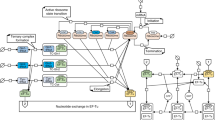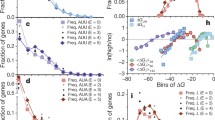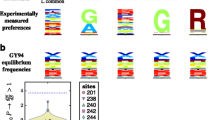Abstract
Antibodies to Escherichia coli translational initiation factors IF2 and IF3 were used for an immunological comparison of unpurified proteins from the following genera: Salmonella, Serratia, Proteus, Aeromonas, Pseudomonas, Streptococcus, Sarcina and Bacillus. Immunological relatedness was compared by Ouchterlony double diffusion experiments and immunoblotting analysis. Immunoblotting is a quantitative technique for measuring levels of specific proteins in crude cell lysates. We have used this technique to measure immunological distance with the assumption that the levels of the various translational components are essentially the same in the different bacterial cells examined. Both immunodiffusion and immunoblotting analysis showed a similar evolutionary relationship between the various species for the two initiation factors examined: (Escherichia=Salmonella>Serratia>Proteus>Aeromonas>Pseudomonas). Little or no crossreactivity was found using either analysis with genera: Streptococcus, Sarcina and Bacillus. Using the immunoblot distance, the two initiation factors were shown to diverge at similar rates. One advantage the immunoblotting analysis has over other immunological techniques is that the antigens can be analyzed structurally. We found, for example, that the two forms of IF2 were present in all bacterial species which cross-reacted with anti-IF2, suggesting that both forms are functionally important. Because of its sensitivity, the immunoblot analysis may be more useful than other immunological techniques in studying species that are more distantly related.
Similar content being viewed by others
Abbreviations
- IF:
-
initiation factor
- MOPS:
-
morpholinopropane sulfonate
- PAGE/SDS:
-
polyacrylamide gel electrophoresis/sodium dodecyl sulfate
References
Baumann L, Baumann P (1978) Studies of relationship among terrestrial Pseudomonas, Alcaligenes, and Enterobacteria by an immunological comparison of glutamine synthetase. Arch Microbiol 119:25–30
Champion AB, Praeger EM, Wachter D, Wilson AC (1974) Micro-complement fixation. In: Biochemical and Immunological Taxonomy of Animals. Wright CA (ed) Academic Press, New York pp 397–416
Cocks GT, Wilson AC (1972) Enzyme evolution in the Enterobacteriaceae. J Bacteriol 110:793–802
Eskin B, Treadwell B, Redfield B, Spears C, Kung H-F, Weissbach H (1978) Activity of different forms of initiation factor 2 in the in vitro synthesis of β-galactosidase. Arch Biochem Biophys 189:531–534
Fox GE, Stackebrandt E, Hespell RB, Gibson J, Maniloff J, Dyer TA, Wolfe RS, Balch WE, Tanner RS, Magnum LJ, Zablen LB, Blakeman R, Gupta R, Bonen L, Lewis BJ, Stahl DA, Leiehrsen KR, Chen KN, Woese CR (1980) The phylogeny of prokaryotes. Science 209:457–463
Geisser M, Tischendorf GW, Stoffler G, Wittmann HG (1973a) Immunological and electrophoretical comparison of ribosomal proteins from eight species belonging to Enterobacteriaceae. Molec gen Genet 127:111–128
Geisser M, Tischendorf GW, Stoffler G (1973b) Comparative immunological and electrophoretic studies on ribosomal proteins of Bacillaceae. Molec gen Genet 127:129–145
Hershey JWB, Yanov J, Johnston K, Fakunding J (1978) Purification and characterization of protein synthesis initiation factors IF1, IF2, and IF3 from Escherichia coli. Arch Biochem Biophys 182:626–638
Higo K, Held W, Kahan L, Nomura M (1973) Functional correspondence between 30S ribosomal proteins of Escherichia coli and Bacillus stearothermophilus. Proc Natl Acad Sci USA 70:944–948
Howe JG, Hershey JWB (1981) A sensitive immunoblotting method for measuring protein synthesis initiation factor levels in lysates of Escherichia coli. J Biol Chem 256:12836–12839
Howe JG, Hershey JWB (1982) Immunochemical analysis of molecular forms of protein synthesis initiation factors in crude cell lysates of Escherichia coli. Arch Biochem Biophys 214:446–451
Howe JG, Hershey JWB (1983) Initiation factor and ribosome levels are coordinately controlled in Escherichia coli growing at different rates. J Biol Chem 258:1954–1959
Howe JG, Yanov J, Meyer L, Johnston K, Hershey JWB (1978) Determination of protein synthesis initiation factor levels in crude lysates of Escherichia coli by a sensitive radioimmune assay. Arch Biochem Biophys 191:813–820
Isono K, Isono S, Stoffler G, Visentin LP, Yaguchi M, Matheson AT (1973) Correlation between 30S ribosomal proteins of Bacillus stearothermophilus and Escherichia coli. Molec gen Genet 127:191–195
Laemmli UK (1970) Cleavage of structural proteins during the assembly of the head of bacteriophage T4. Nature (London) 227:680–685
Lestienne P, Dondon J, Plumbridge JA, Howe JG, Mayaux JF, Springer M, Blanquet S, Hershey JWB, Grunberg-Manago M (1980) Expression of the gene for E. coli initiation factor IF2 in vivo and in vitro. Overproduction in recombinant plasmid bearing strains. Eur J Biochem 123:483–488
Lindahl L, Zengel JM (1982) Expression of ribosomal genes in bacteria. Adv Genet 21:53–121
Lowry OH, Rosebrough NJ, Farr AL, Randall RJ (1951) Protein measurement with the Folin phenol reagent. J Biol Chem 193:265–275
Parker J, Flashner M, McKeever WG, Neidhardt FC (1974) Metabolic regulation of the arginyl and valyl transfer ribonucleic acid synthetases in bacteria. J Biol Chem 249:1044–1053
Plumbridge JA, Howe JG, Springer M, Tonati-Schwartz D Hershey JWB, Grunberg-Manago M (1982) Cloning and mapping of gene for translational initiation factor IF2 in Escherichia coli. Proc Natl Acad Sci USA 79:5033–5037
Rocha V, Crawford IP, Mills SE (1972) Comparative immunological and enzymatic study of the tryptophan synthetase β2 subunit in the Enterobacteriaceae. J Bacteriol 111:163–168
Sabatini LM, Macklin MD, Chooi WY (1982) Homology between Drosophila melanogaster and Escherichiac coli ribosomal proteins. Molec gen Genet 187:370–374
Tafler SW, Setlow P, Levine L (1973) Serological relatedness of bacterial deoxyribonucleic acid polymerases. J Bacteriol 113:;18–23
Tronick SR, Ciardi JE, Stadtman ER (1973) Comparative biochemical and immunlogical studies of bacterial glutamine synthetases. J Bacteriol 115:858–868
Wilson AC, Carlson SS, White TJ (1977) Biochemical evolution. Ann Rev Biochem 46:573–639
Author information
Authors and Affiliations
Rights and permissions
About this article
Cite this article
Howe, J.G., Hershey, J.W.B. The rate of evolutionary divergence of initiation factors IF2 and IF3 in various bacterial species determined quantitatively by immunoblotting. Arch. Microbiol. 140, 187–192 (1984). https://doi.org/10.1007/BF00454924
Received:
Accepted:
Issue Date:
DOI: https://doi.org/10.1007/BF00454924




